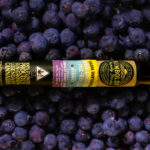
What companies have done a great job with branding?
I really like what Canna Bath Co. has done. They were having difficulties getting products into mainstream retailers and sales were flat, so they decided to develop a new logo and packaging for their wonderful infused bath products. With the new high-end look, the product was accepted at several major retail chains and sales have doubled.
Doug’s Varin has a unique set of cannabinoids that set it apart from almost everything else on the market. California Cannabinoids, which owns and exclusively markets the strain, needed distinctive packaging to attract attention and let consumers know the product is different from everything else. The beautiful packaging has opened the door to stores California-wide.
Canndescent is one of my favorite brands; these folks really did it right. They created a beautiful palette and apply it perfectly to their strains and throughout their product lineup. —Kary Radestock, co-founder and CEO, Hippo Premium Packaging.

How can cannabis companies avoid common branding mistakes?
These days everyone with a computer thinks they are a graphic designer. Everyone with a camera thinks they are a photographer. The sad fact is, they’re not. Do yourself a favor and hire professionals. When you go to the store, whether a cannabis retailer or mainstream, look at the successful products, not ones designed by an amateur. Successful companies know in order to compete in the market, they need to invest in quality branding, marketing, advertising, and design.
Secondly, don’t copy someone else’s work. I’ve seen so many look-alike products and logos that it’s almost laughable. As the market tightens and gets even more competitive, they will all follow each other right out of business.
Lastly, understand a brand is more than a logo. A brand is what you want your customers to feel about your company and products. Your brand must live within your company as well as on your packaging and marketing materials. Your employees, the way you treat your vendors and customers, and the style in which you write all are part of your brand. —Randall Huft, president and creative director, The Innovation Agency

What are the keys to successful cannabis branding?
First, understanding how your brand is much more than your logo is imperative. Your brand is the essence of your company and how your target audience will view your company. It is not a one-time process or exercise. Branding is a fluid, ongoing message that emotionally speaks to the public about your experiences, history and, most importantly, services or products. In the beginning, your brand, your logo, packaging, and content must start with a bang. This will create immediate interest.
Second, the key to creating a successful brand is all about relating emotionally to your target audience. You need to do your homework; look into who is engaging with your product or service. If you do not know where to start, hire a branding expert or team to analyze the market and direct the first steps. Answer content message questions: “Who are we? Why are we? How are we the best?”
Finally, you must consider your brand as an extension of your company. Think about the significance your brand may bring to consumers, businesses, market variety, culture, and community involvement. —Olivia Mannix, founder, Cannabrand

How should companies approach the brand-creation process?
Initially, drill down on goals and objectives, end-user targeting, pricing structures, and projected growth in the market. Evaluate the potential of each product, and then strategize on brand positioning. This is where the magic begins. Create a background story while establishing a point of difference. Armed with this data, move to creative and a sales-and-marketing plan. More and more brands are recognizing the power of stories to transform their presence and establish their identity.
We love brands where we see a fast-track for growth; however, products that work are a must. Great branding sells products initially, but sustainable growth requires quality and results-driven marketing that delivers on the brand promise. We don’t like “me too” companies—generic brands that are mediocre. Unique, innovative, results-driven brands create loyalty and earn customer trust. —Christine King, CEO, Madison 8

What is Wick & Mortar’s process when working with new branding clients?
In the initial meeting we do a lot of listening. It’s often in that first call that you really hear the essence of the brand a client is trying to create. But we’re also brutally honest during this phase of the process. If we think a brand name or an existing website is simply not a usable foundation, we will tell you that. And we only take on projects that we feel can be built into something great and if it’s something we’d be proud to highlight on our own website.
When we onboard a new client, the first thing we complete is a creative brief. This is where we ask carefully crafted questions to extract deeper insights into their business needs, values, vision, and more. The information we gather at this stage forms the foundation of everything we build in the future. This foundation continues to gain strength as we build out mood boards, potential names, and logo marks with custom color palettes.
Our process is designed to educate our clients along the way and allow them to begin to speak the language of great design. This means when we finish our brand identity, clients will have a brand that is authentically them, which allows for the brand to grow organically with them and always seem true to their market. Jared Mirsky, CEO, Wick & Mortar













